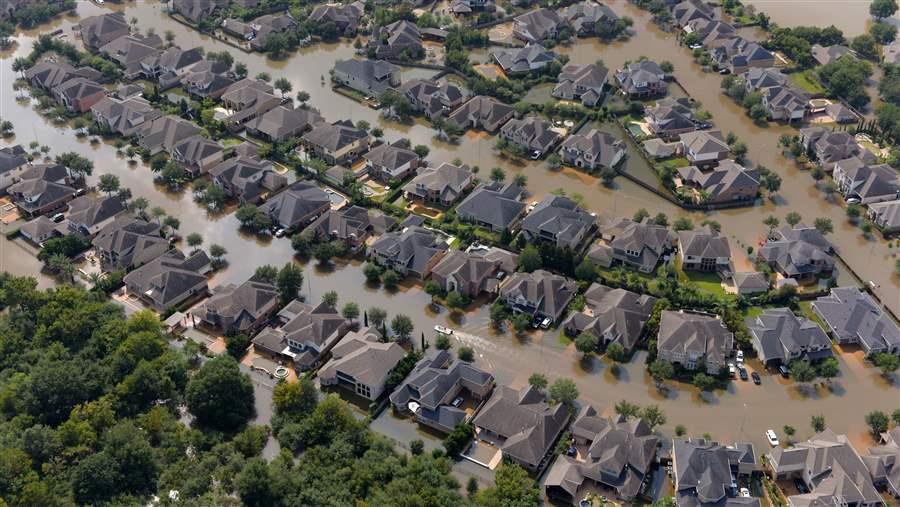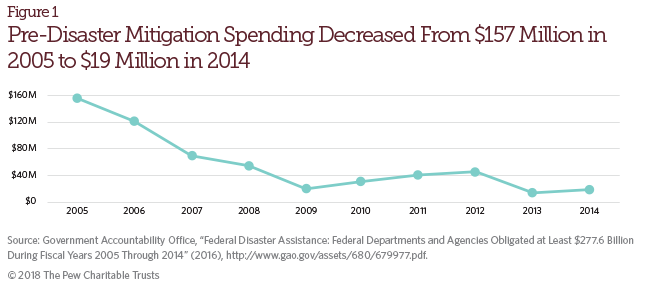Needed: A New Federal-State Partnership for Flood Mitigation
State revolving loan funds would reduce risk and save taxpayers money

Floodwaters inundated many Houston neighborhoods during Hurricane Harvey.
Xinhua/Yin Bogu via Getty ImagesOverview
Flooding is the most costly and common natural disaster across the U.S.,1 claiming lives, damaging households and businesses, and straining government budgets for flood response and recovery. As severe weather events have spiked in recent decades, it is clear that the federal government must break the cycle of paying to rebuild properties in vulnerable areas that flood repeatedly. It can do so — with a $6-to-$1 return on investment2 — by increasing support for state disaster preparedness efforts, starting with a new revolving loan fund program.
Current programs fall short of flood mitigation needs
Two key grant programs of the Federal Emergency Management Agency (FEMA) support projects aimed at reducing disaster risk: the Hazard Mitigation Grant Program and the Pre-Disaster Mitigation Grant Program (PDM). However, neither has been sufficient to address the nation’s pressing need to prepare for floods. Of the $277.6 billion that the federal government spent on disaster assistance from 2005 to 2014, very little went to mitigation.3 In fact, spending on PDM grants fell from $157 million in 2005 to $19 million in 2014.4
States need a stable source of funding for more disaster mitigation
State revolving loan funds would enable more communities to take measures to reduce risk, such as elevating buildings, putting vents in the lowest level of structures to reduce pressure on the walls and allow floodwater to pass through, buying out homeowners, and larger-scale projects such as improving stormwater management and building berms or flood walls.
Each fund would be capitalized with dollars from FEMA and the state. States would manage their funds under general principles established by FEMA but tailored to the state’s unique flood risks and priorities. As payments on outstanding loans are returned to the state funds, these flood mitigation dollars would become available for additional projects. This approach allows each state to establish a relatively predictable flow of money to a pipeline of new projects. In this way, even a modest federal expenditure can leverage a large return on investment and foster an enduring commitment to preparation and mitigation.
The revolving loan fund is a tested model
Many states and municipalities have experience with revolving loan funds. They have been used to support affordable housing, renewable energy, clean water, energy efficiency, and other community interests.
The Clean Water State Revolving Fund program, for example, has financed improvements to wastewater infrastructure. From its inception in 1987 through 2016, the program has leveraged $41 billion in federal monies for $118 billion worth of clean water infrastructure.5 Its success led to the creation in 1996 of the Drinking Water SRF. Just over $19 billion in federal assistance to this program has fostered more than $32.5 billion in investments through 2016.6
A better investment of our taxpayer dollars
Severe weather events have spiked in recent decades. Since 2000, flood-related disasters in the U.S. have accounted for more than $750 billion in losses,7 with taxpayers footing much of the bill through federal recovery programs. Congress must invest more wisely by allocating money to a revolving loan fund program for flood mitigation and encourage states to participate. It is vital to establish this program soon to enable communities to reduce the risk of lives lost and damage before the next storm hits.
Endnotes
- The Pew Charitable Trusts, “Flooding Disasters Cost Billions in 2016,” Compass Points (blog), Feb. 1, 2017, http://www.pewtrusts.org/en/research-and-analysis/blogs/compass-points/2017/02/01/flooding-disasters-cost-billions-in-2016.
- National Institute of Building Sciences, “Natural Hazard Mitigation Saves: 2017 Interim Report” (2017), https://www.nibs.org/page/mitigationsaves.
- Government Accountability Office, “Federal Disaster Assistance: Federal Departments and Agencies Obligated at Least $277.6 Billion During Fiscal Years 2005 Through 2014” (2016), http://www.gao.gov/assets/680/679977.pdf.
- Ibid.
- Environmental Protection Agency, “Learn About the Clean Water State Revolving Loan Fund,” accessed Feb. 6, 2018, https://www.epa.gov/cwsrf/learn-about-clean-water-state-revolving-fund-cwsrf.
- Environmental Protection Agency, “How the Drinking Water State Revolving Fund Works,” accessed Feb. 6, 2018, https://www.epa.gov/drinkingwatersrf/how-drinking-water-state-revolving-fund-works.
- National Oceanic and Atmospheric Administration, “Billion-Dollar Weather and Climate Disasters,” https://www.ncdc.noaa.gov/billions/events/US/2000-2017. This statistic represents a total of billion-dollar disaster events from 2000 to 2017.













